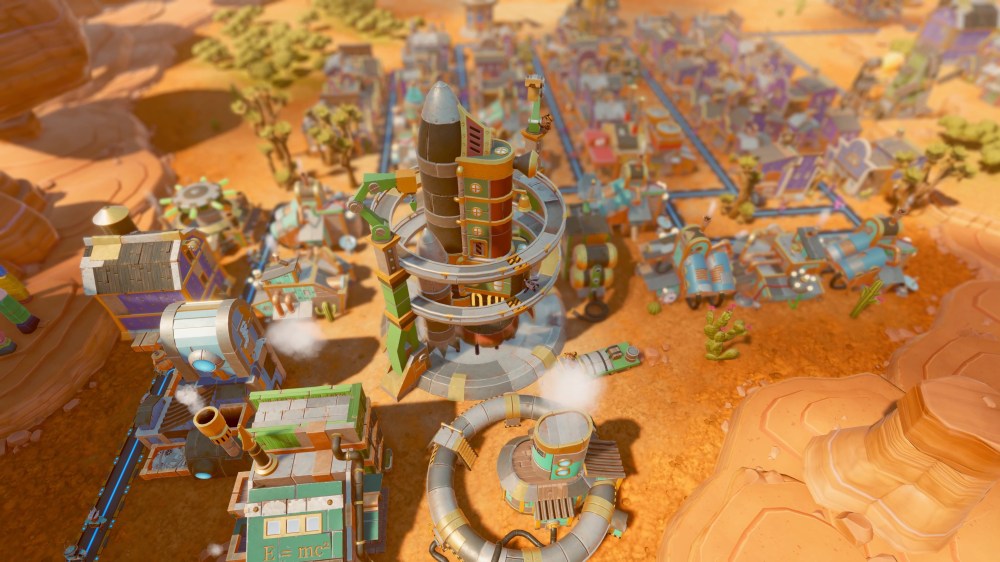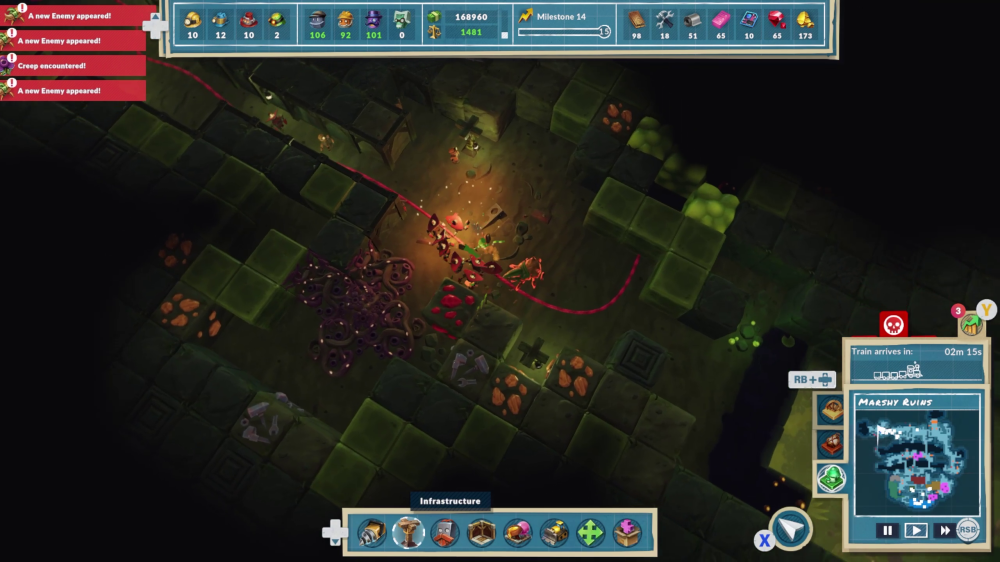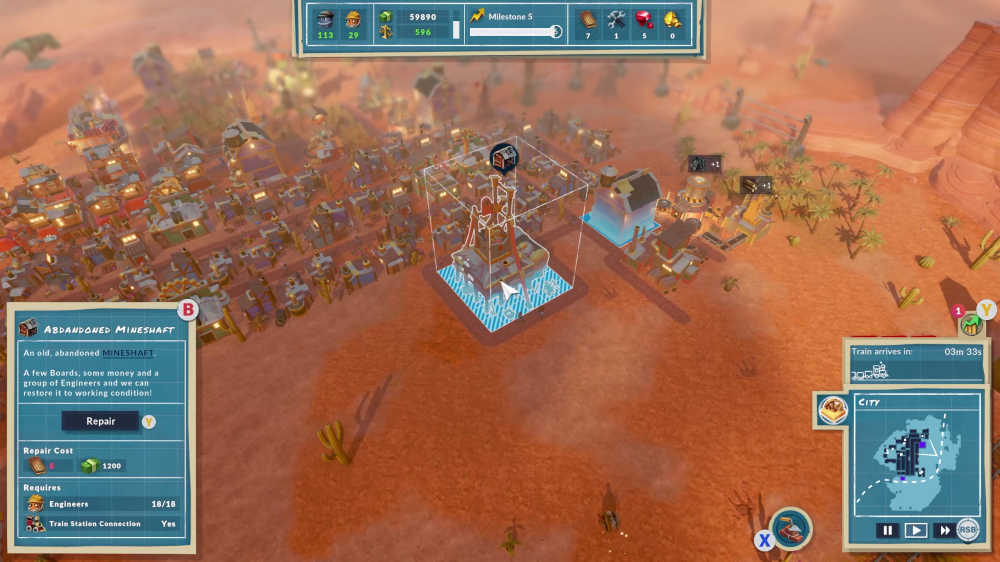Steamworld Build is a city-builder for people who want to construct a flourishing metropolis but struggle with the complex chains of something like Anno 1800. It’s a more relaxed city-builder, one that is very easy to play and as a result, also lacks the depth and challenge found in other games in the genre. Go in understanding that though, and I think Steamworld Build is a relaxing way to spend a few hours, especially if you have Game Pass where it launched on day 1.
Steamworld Build has two distinctive layers: the first is a pretty laid-back city-builder where you plop down buildings to meet the needs of your citizens. As you move from basic citizens to engineers to genteel aristobots, those needs and desires become more complex, requiring more resources, production buildings and space.
The second layer kind of relates to the older Steamworld Dig games, having you command robots to clear out three levels of a mine in search of the rocket parts needed to escape the dying world.
If that second part sounds far less laid-back than the first part, don’t worry. Although the game weaves a very basic story involving the inevitable destruction of the planet unless you can escape using some ancient buried technology, there’s absolutely no sense of urgency behind that ultimatum. Whereas Frostpunk made every decision and every moment feel urgent and constantly threatened you with a population willing to toss you on your ass because you decided to “recycle” human bodies, Steamworld Build literally does not let you fail.
Available On: PC, Xbox Series S/X, PS5, PS4, Switch
Reviewed On: PC (Game Pass)Developed By: The Station
Published By: Thunderful
That’s probably going to be the biggest sticking point for genre veterans who like to have their resource-management and planning skills put to the test. There are games out there where it’s possible to tank the entire economy, or where poor choices can lead to people dying, games that punish your inability to think your way out of a wet paper bag. This is not one of them, even in the slightest. Sure, it means there are no stakes to speak of, but when there are no stakes you can kick off your boots, put your feet up and relax for a bit.
On the surface of whatever planet Steamworld Build takes place on, the general flow is to chuck down homes to attract robotic workers. Their needs and wants are divided between two types of building: the first manufactures finished items, like cowboy hats, from various resources and can thus be put down anywhere, so long as they have a warehouse nearby to ferry goods back and forth. Unlike some other games, there’s no penalty for plopping these down next to homes, but it’s still a good idea to keep the industrial in its own little zone. Service buildings are slightly different in that they must be placed down close to workers and have a limited range of influence, although that can be boosted by higher-quality roads. That means building them right in the middle of the housing areas, surrounding for maximum coverage.

After meeting the requisite Milestones, usually related to how many robots of a specific class are living in your city, you’ll start moving up the very linear path to success, opening up new types of citizens and thus more complex chains of production. The fancy-pants aristobots, for example, want readily available fine dining which means you’ll need a strong oil production, a robotic farm and a few other key resources that can be combined to form the final product. Engineers are a little simpler in their desires: some whiskey, a saloon and a place to wash up.
However, all of this is done linearly, which is unusual for a city builder. The Milestone system means you’ll unlock the same options and build the same pipelines in the same order every single time which makes the whole concept of looking after a city of robots…well, robotic.
There’s also a niggle I want to address that other city-builders are guilty of too, and that’s the domino effect. You see, each house you place can hold a maximum number of workers who in turn staff the various factories and services, as well as pay taxes. The amount of robots per house is based on how many of their needs are being met. Because of this, if a single resource or product doesn’t quite meet demand, a bunch of robots will suddenly leave their houses automatically, which in turn will result in other buildings no longer having enough staff which will then reduce the speed at which other items are made, causing even more robots to get up and leave.
It can be a frustrating cascade to be caught up in, one that I still have nightmares from in Anno 1800 where entire cities could crumble because the local shops briefly ran out of sausages or in the more cent Pharoah: A New Order where streams of citizens would abandon their homes. But thankfully because Steamworld Build is so much more chill, the sea of red faces above buildings can be easily rectified. Suppose everything really does go down the poop chute. In that case, there’s always the option of hammering down heaps of basic worker buildings to collect the tax and then use that money to buy the necessary resources from the train which stops by regularly. The same train also provides access to handy building upgrades, too.

Part of the reason that the city-building side of things is so forgiving is so that you can spend time down in the mines without having to worry about everything on the surface catching fire and burning down without you even noticing. Most of what you do is in aid of getting further and further into the mine in search of those vital rocket parts, with new Milestones hit unlocking the tech needed to make more progress. Likewise, digging out the three floors of the mine will uncover new resources like oil and dirty water that can be sent back up to the surface and refined to please the next social strata.
Let’s delve into the whole mining layer a little more, though. In a lot of ways it plays like a Dungeons game: you toss down quarters for your basic miners, prospectors, mechanics and security to reside, the size determining how many of them you have to command. Then it’s a case of using the dig tool to designate which areas you want stripped, all while making sure to shore it up with pillars. As more and more earth is moved, more resources like gas and ironium will be discovered and returned to the surface.
The biggest worry underground is the enemies that spawn and then try to wreck your machines or interrupt your mines from unearthing the latest rocket part. Their existence brings out the third layer in Steamworld Build: the tower defence layer. Okay, maybe calling it a layer is overselling it a little, as there are really just a couple of turrets you can install and their main job is to guard the hives which will periodically spew enemies into the world, kind of like Facebook.
Like the city-building layer, digging through the dirt isn’t very deep, but when it’s combined with the act of building a town the two elements form an enjoyable whole. Both elements are nicely tied together so that progressing in one naturally pushes the other forward as well, although I did find there were long periods of time where I’d do nothing but sit in the mine and search for parts. My city would continue to chug away, requiring no effort on my part. On the one hand, that’s a sensible design choice because trying to keep an eye on both constantly could be a headache, but on the other hand it also meant that sometimes it seemed like one part was being forgotten about.

There’s also a bit of a problem with the replay value, or the lack of it, to be exact. The first successful city and rocket launch will probably take around 6-10 hours. After that, you can fire up a new game at any time and select from a handful of locations, each one looking a little too similar to the others aside a couple of props. There’s a vaguely Jurassic Park-themed area, for example, while another area’s only notable feature is a small bridge spanning a chasm. None of these locales alter how you approach building a city, never push you away from sketching out the standard grids, and when you combine that with the very linear progression it doesn’t lend itself very well to repeat plays.
Nor do the rewards. Each map offers a special building as a reward for completing it that can be built in subsequent playthroughs – one that boosts how many personnel you get in the mines, or another that increases the frequency of trains and gives a discount on the goods they sell. Handy things, no doubt, but not very thrilling and make an already easy game even easier.
Steamworld Build is the very first game in the franchise, which spans multiple games across multiple genres, to be made by a different studio, and it’s unfortunate that it also happens to be, in my opinion, the weakest of the bunch. That doesn’t mean it’s not still a pretty good time though, and certainly a good addition to the Game Pass catalogue. Maps that pushed you to build a bit more creatively and a slightly less stiff progression system could have elevated this one up to a four, I reckon.
Still, it’s well worth playing if you already have Game Pass or if you’re maybe a grizzled city-building veteran who fancies something a tad simpler before they delve back into spreadsheets and optimal street layouts.





